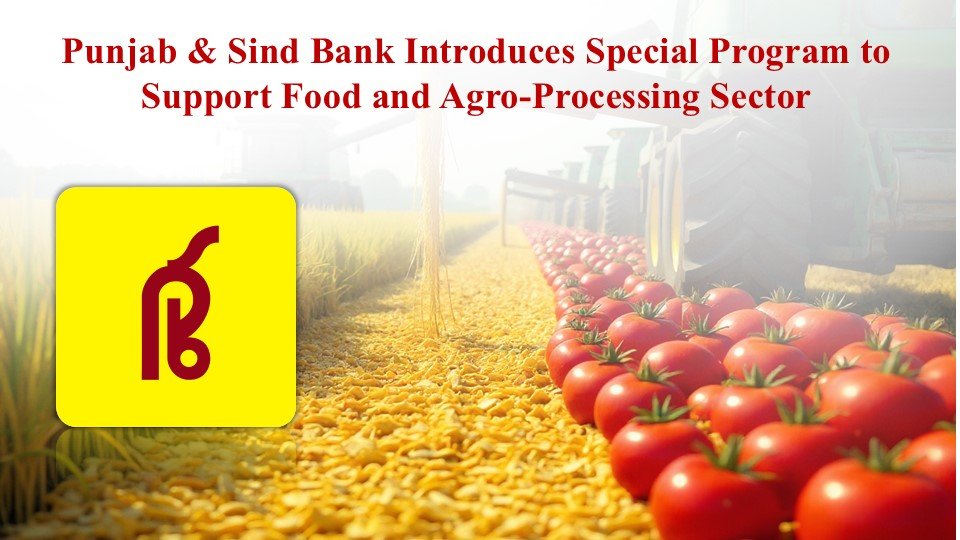Hello, my lovely people! What’s for food today? Bored with the same vegetables, tubers, spinach and fruit!? How about some flowers we eat as vegetables? Sounds nice and colourful? Then follow this article to learn more about the flowers used as vegetables in our daily foods.
Food is an essential part of our lives and it forms the basis for the development or deterioration of our health. A balanced proportion of various components ensures good health. These are derived mainly from the plants and their various parts. The flowers in general have a lesser significance as food and remain as the reproductive organ. But the reality is that flowers are also rich sources of nutrients and flowers we eat as vegetables will help us get the nutrients required by providing a variety.
History dates back to the times of ancient Greece, Rome and Egypt when the flowers were eaten as vegetables in purees, as a salad dressing, as a garnish in soups and as additions in cakes and cookies. Indians have incorporated the flowers as condiments and flavouring rice and meat while the Chinese have used them in medicinal preparations. Teas and liquor were a major food in which flowers were incorporated to impart their medicinal property, taste and colour.
The usage of flowers that we eat initially started with the tribal people who used the flowers as food. Later these recipes started travelling through the generations and had become a part of our daily food. In fact, some flowers we eat as vegetables are also closely associated with certain traditions and festivals to keep them alive and going. Let us further see about the flowers used as vegetables in various dishes, their nutrients and health benefits.
Read More:
- 10 Popular Creeper Flowering Plants For a Garden Paradise
- 365 days Flowering Plants in India | All Season Flowering Plants in India
Common Flowers We Eat As Vegetables in India | Flowers We Eat As Vegetables
Banana Blossom
Banana is a very common plant known to all and its flower eaten as vegetable is very common. This humble plant provides us with a lot of products from almost every part of it. As like raw and ripe fruit, banana flowers we eat as vegetables in most parts of our country. It is a powerhouse of nutrients including proteins, Vitamin C, Potassium, Calcium, Magnesium, Phosphorus, Copper, Iron, anti-oxidants and free radicals.
The flowers are present within the purple colour bract and are yellowish brown in colour. The preparation of the flower for cooking is a bit tedious and involves the removal of the purple-coloured outer cover, rubbery and thick stamen from the flowers.
Medical Benefits of Banana Blossom
- Aids in weight loss
- Natural mood boosters
- Reduce anxiety
- Encourage gut-bacteria
Dishes made from Banana blossom
- Thoran (stir fry)
- Vada
- Adai Vazhaipoo
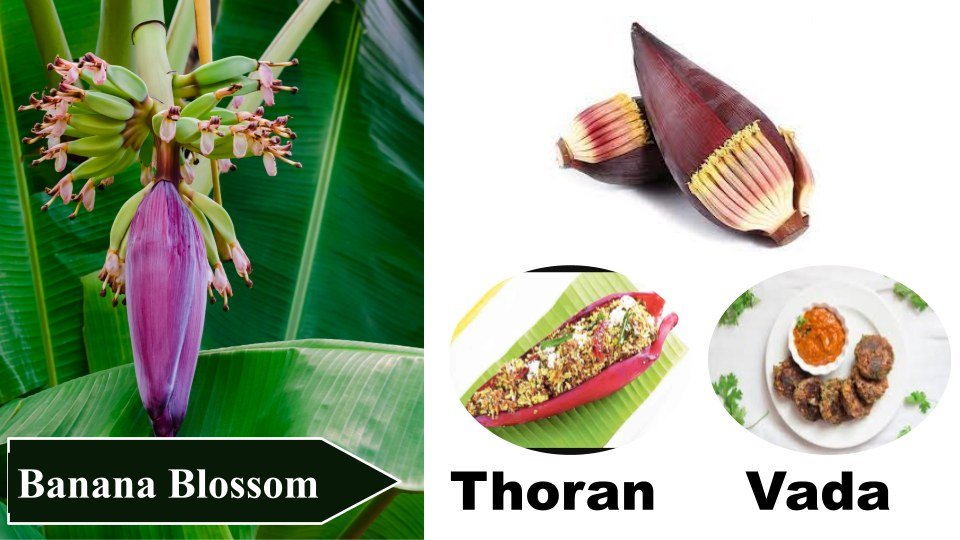
Moringa Flower
A native of the Himalayan foothills, West Bengal and Odisha, Moringa tree’s flowers we eat as vegetables very commonly. Moringa, also called as the super-food, is packed with nutrients like Magnesium, Potassium and Proteins and is also rich in fibres.
The flowers are small and white in colour and borne in clusters. They are available throughout the year in the tropics and only in spring in the temperate regions. They have a subtle sweet flavour and taste like mushrooms when cooked.
Medical Benefits of Moringa Flower
- Reducing muscle inflammation
- Cures muscle spasms and tension
- Helps in combatting malnourishment
Dishes made from Moringa Flower
- Fritters
- Chutneys
- Tea
- Salad garnishing

Pumpkin Flower
It is not just the large round pumpkins, but, the big yellowish orange flowers are also edible. Yes, pumpkin flowers we eat as vegetables, especially in the Eastern and North Eastern parts of India. This flower is rich in fibre, copper, folate, Vitamin A and B9. They have a sweet mellow taste and a mild flavour just like the fruit.
Pumpkin flowers are available all round the year. For culinary purposes, the male flower can be used. It can be differentiated from the female flower which has a small pumpkin as its base. By removing the stem and the stamens, the flower is ready to cook.
Medical Benefits of Pumpkin Flower
- Enhance immunity
- Improves vision
- Strengthens bones
- Cures male fertility issues
Dishes made from Pumpkin Flower
- Pakoras
- Thoran
- Soups and Salads

Rose Flower
The ‘Queen of Flowers’ – Rose is also no exception to the flowers we eat as vegetables and has a lot of health benefits. Roses are rich sources of Vitamin C, Vitamin A, phenolics, anti-oxidants and anti-inflammatory agents. In addition, it has a low-calorie count and pain-relieving properties.
Roses are grown in all regions and in all seasons ensuring year-round availability. All species of roses are edible, but those that have a good fragrance are tastier than the non-fragrant ones. Removal of the stem, calyx and the petal base is to be done before cooking.
Medical Benefits of Rose Flower
- Maintain healthy cholesterol
- Reduce inflammation and soreness
- Natural coolant
- Aids in digestion
- Helps in reducing cancer, heart disease and diabetes
Dishes made from Rose Flower
- Gulkhand, Sharbat and Syrups
- Tea, jams and cocktails
- Sweets and Confectioneries
- Flavouring rice

Jasmine Flower
Mogra, Malligai poo, Madanban, Jai, and Chameli are the various names for this sweet-scented flower. But does it sound strange when I say that jasmine flowers we eat as vegetables? It should not, because, mogra flowers are edible and have been in the cooking for a long period of time. The flower has anti-spasmodic and aphrodisiac properties and is rich in antioxidants.
It is a seasonal flower and is available during the months of March to September. During this time, the flowers are collected and dried for use all year round. The petals along with the small stem are edible.
Medical Benefits of Jasmine Flower
- Lower blood pressure and Cholesterol
- Weight loss
- Regulates ageing
- Strengthen immune system
- Controls insomnia
- Mood enhancer and energy booster
Dishes made from Jasmine Flower
- Flavouring rice and pulao
- Sewali phool pakora from night jasmine
- Tea
- Jello and Confectioneries
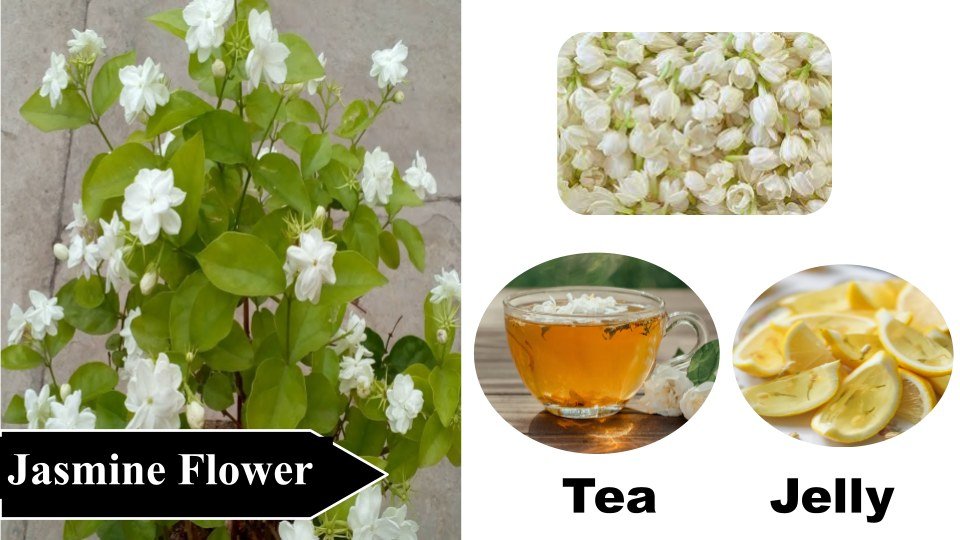
Read More:
- Top 25 Flowering Trees in India: Colorful Display of Nature
- Amazing 10 Indoor Flowering Plants in INDIA
Hibiscus Flower
Hibiscus flowers are loved by all for their vibrant colours that make our garden look beautiful. Similarly, the Hibiscus flower can also make our body beautiful and healthy with its various nutrients. Yes, Hibiscus flowers we eat as vegetables in various ways. It is rich in Vitamin C, minerals, anthocyanins, and anti-oxidants. It is low in calories and high in fibre
Of the many species of hibiscus, the Red Sorrel hibiscus, Cranberry hibiscus and the Chinese Hibiscus are 3 species of flowers we eat as vegetables. The petals and calyx, both are edible. It gives a sweet-sour citric flavour and a hint of bitterness or tart flavour when cooked.
Medical Benefits of Hibiscus Flower
- Promotes weight loss
- Prevents anaemia
- Lowers blood pressure and cholesterol
Dishes made from Hibiscus Flower
- Chutneys
- Preserves, juices and fruity cakes
- Dried forms for garnish
- Teas and sparkling waters
- Rasam
- Stir-fried as Thoran
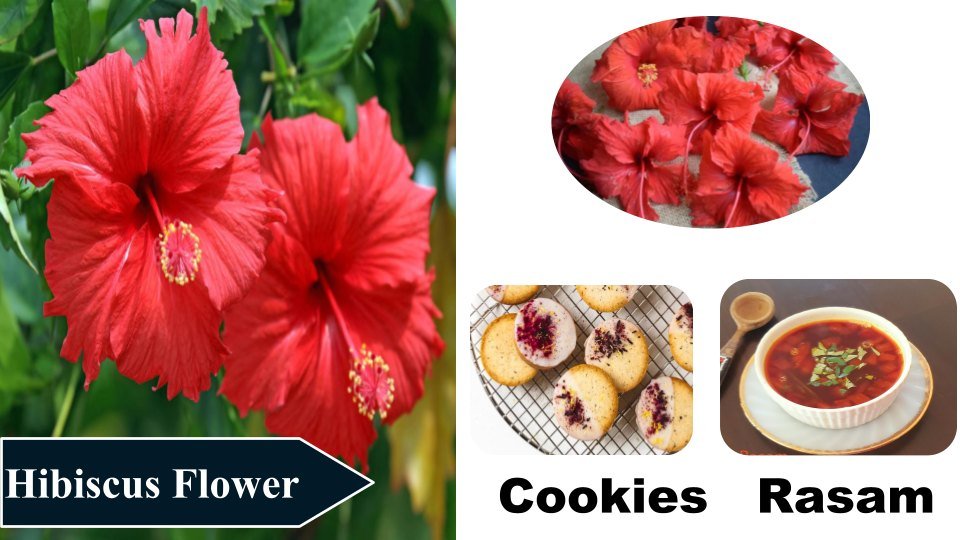
Papaya Flowers
If you are a lover of North East Indian cuisine, then you should not miss out on the dishes made from papaya flowers. Papaya flowers eaten as vegetables provide us with a lot of nutrients including vitamins A, C and E, Folate and are rich in antioxidants like beta carotene. They have high amounts of fibre
The male flowers are only used for culinary purposes. They are small in size, yellowish-white in colour and are borne in clusters. The flowers we eat as vegetables have a bitter taste when cooked.
Medical Benefits of Papaya Flower
- Boosting the body’s metabolism
- Helps in thorough digestion
- Management of blood cholesterol
- Control blood sugar levels
Dishes made from Papaya Flower
- Fritters
- Stir fry
- Fish curry with potato
- Decoction along with leaves for abating Dengue fever

Mahua Flower
The Mahua tree is seen growing in the tropical plains of India, Sri Lanka, Nepal and Myanmar. It has been utilized by the tribal people to a large extent and has served as their ‘Tree of Life’ for them. It is high in sugars and rich in vitamin C, Calcium and Phosphorus. It also provides proteins and fats.
Blooming in the months of March and April, the Mahua flowers we eat as vegetables are borne in green or pink furry bunches with 10 to 12 cream-coloured flowers. They are fleshy in texture and eaten fresh or in dried form. The flowers provide a subtly sweet flavour. It is mixed and powdered with flour and used for making baked foods.
Medical Benefits of Mahua Flower
- Natural cure for asthma and respiratory illness
- Improves eyesight
- Cures skin diseases
- Improves heart and liver functioning
Dishes made from Mahua Flower
- Halwa, meethi puri and in baked foods
- For desserts and jams,
- Flower juice for lactating mothers
- Mahua Liquor
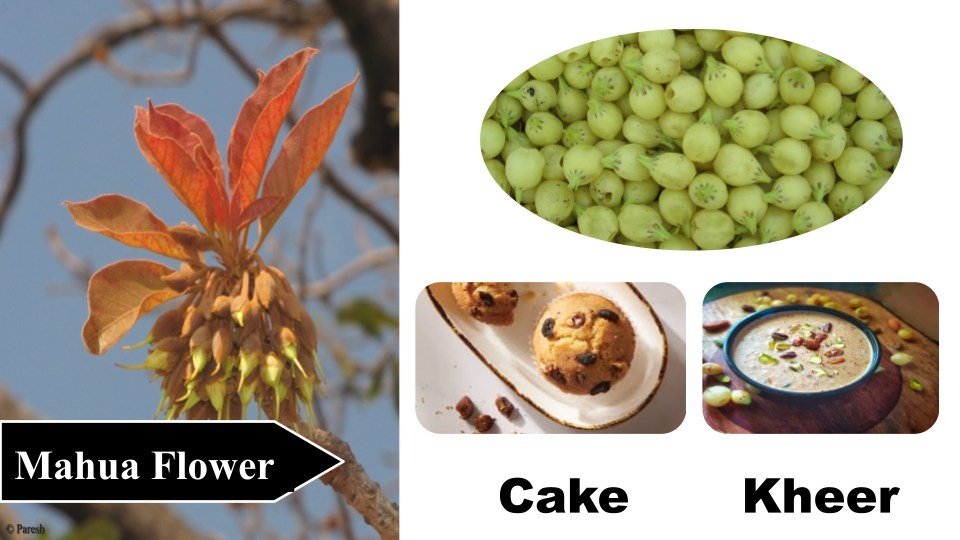
Tamarind Flower
The large tamarind trees and their brown fruits never miss from our eyes, but how about the small flowers? Have we really seen it? Many of us wouldn’t have. They usually get hidden within the leaves in their large branches. But from now on, do not miss them because these flowers too have hidden within them a lot of nutrients and benefits.
Flower buds are red in colour and when in full bloom the petals are pale yellow and borne in clusters. The flowers we eat as vegetables add tartness and sweetness to the dishes when cooked.
Medical Benefits of Tamarind Flower
- Digestion booster
- Controls insulin and diabetic-friendly
- Treat urinary infections in women
Dishes made from Tamarind Flower
- Lentil curries
- Chutneys
- Stew
- Dried form as garnish
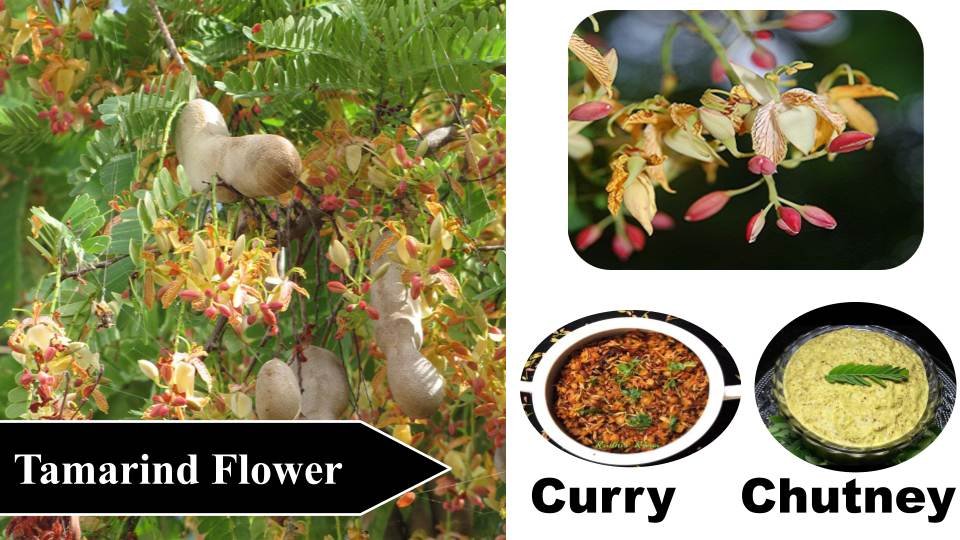
Neem Flower
Neem is very well known for its medicinal benefits. It is considered a sacred tree in most parts of our country. All parts of the tree provide us with a lot of health benefits and the flowers are also no exception to it. The small flowers are rich in fibre, protein, calcium, phosphorus and carbohydrates. The flowers we eat as vegetables taste bitter when cooked. But it is that bitterness that keeps us in good health.
Neem flowers are whitish-yellow in colour and available in the summer months of April to June. During the festivals of Chitirai New Year and Ugadi, bitter-tasting neem flowers are incorporated into the food along with the 5 other tastes as a means of signifying the various states of life in the year to come.
Medical Benefits of Neem Flower
- Promotes gut health
- Cures stomach ache, gas and constipation
- Treats intestinal worms
- It is a natural antiseptic
- Reduces blood sugar
- Improves hair and skin quality
Dishes made from Neem Flower
- Chutney
- Curry, subzi and rasam
- Sharbat
- Neem flower in raitas
- Dry roasted flowers as garnish

In addition to these 10, let me also share with you, 5 more common flowers that we eat as vegetables aka edible flowers.
- Cauliflower, the unopened flower buds are rich in vitamin C, vitamin K, and folates and rich in fibre and reduce the risk of cancer and heart diseases. These are common flowers we eat as vegetables all around the world.
- Broccoli is one of the flowers we eat as vegetables that have high amounts of antioxidants, fibre, vitamins C and K, potassium and iron. It helps boost the immune system and disease prevention, especially in the eyes and heart
- Artichoke flowers we eat as vegetables mostly in continental and oriental cuisines. They provide us with nutrients like folates, copper, magnesium, phosphorous and potassium. They are also rich in vitamins B and C and aid in curing heart diseases and digestion issues.
- Marigold is used in the dried form as garnish and in salads. The attractive orange colour is rich in antioxidants like anthocyanins. They are used a lot in the nutraceutical industries
- Violets and pansies add violet and blue hues to the foods like salads as a garnish. These are also rich in antioxidants, which help in improving the immune system.
How to Prepare Flowers for Culinary Usage | Flowers We Eat As Vegetables
| Sl.No | Name of Flower | Preparation for usage | Dishes that can be made | Nutrient content | Health benefits |
| 1 | Banana blossom | Removal of outer bract and thick stamen | Stir fry, vada, curries | Vit. C, minerals, antioxidants | For weight loss, mood enhancers |
| 2 | Moringa flower | Removal of small stems attached to flower | Stir fry, fritters, tea | Minerals, protein, fibre | Reduce muscle spasms, tension and inflammation, fight malnutrition |
| 3 | Pumpkin flower | Male flower to be used, remove the stems and stamens | Pakora, thoran, soup and salad | Folates, Vit A & B9, Copper, iron | Improves vision, immunity, and bone strength |
| 4 | Rose flower | Remove the petals from the stem and the stamen | Gulkhand, confectioneries, teas, syrup, sharbat | Vit. A & C, antioxidants | Natural coolant, aids in digestion, cures heart and cancer |
| 5 | Jasmine flower | The whole flower with stem can be used | Teas, aromatics for pulao, pakora | Aphrodisiac, antispasmodic and antioxidant | Energy booster, cures insomnia, lowers cholesterol and body weight |
| 6 | Hibiscus flower | Remove the stems. Petals and calyx can be eaten | Tea, Chutney, baked foods, candies, thoran, rasam | Fibre, Vit. C, minerals and antioxidants | Reduce muscle spasms, tension, and inflammation, fight malnutrition |
| 7 | Papaya flower | The male flower is edible, remove the flowers from the stems | Stir fry, Decoctions, in fish curry | Vit. A, C and E, folates and antioxidants | Improves metabolism, lowers blood sugar and cholesterol |
| 8 | Mahua flower | Whole flower in fresh or dried form | Sweets, confectioneries, liquor | Sugars, Vit. C, minerals | Cures lung and skin disease, and improves vision, heart and liver functions |
| 9 | Tamarind flower | Remove the small stems before cooking | In curries, chutneys and stew | Antioxidants, vitamins and minerals | Treat urinary infections and control blood sugar |
| 10 | Neem flower | Removal of the small stems attached to flowers | In raita, rasam, curries, dry roasted form as a garnish | Rich in fibre, minerals and proteins | Treats stomach ailments and worms, antiseptic and improves hair and skin health |
Read More:
- Dazzling 15 Indoor Plants for Oxygen That Boost Your Health
- 13 Different Types of Money Plant for Wealth and Good Vibes
Conclusion | Flowers We Eat As Vegetables in India
Flowers as a part of food started very early in time. It was an essential part of every day’s food. But when the period of industrialization took over, the flowers eaten as vegetables were not possible to commercialise and its usage faded away with time. Now when we face the issues of deficiency of nutrients and start the search for produce, the age-old practice of including flowers in regular food items comes in handy. Thus, it is a cycle and perhaps, a virtuous cycle indeed where flowers are used as food in Indian cuisine.
Flowers have a lot of hidden nutrients within them and it is up to us to explore and bring them out. With proper care in sourcing, cleaning and preparing dishes, the above-mentioned list is just inexhaustive and the sky is the limit for flowers used as vegetables.
To all the cooks out there, what’s the new flower we eat is on your menu today!?
Latest Post
- November Issue 2025- Times of Agriculture Magazine
- Punjab & Sind Bank Introduces Special Program to Support Food and Agro-Processing Sector
- Beyond Classrooms and Gardens: How a Professor Turned His Passion into Purpose
- October Issue 2025- Times of Agriculture Magazine
- Top 10 Pesticide Companies in the World
- September Issue 2025- Times of Agriculture Magazine
- Top 15 Fertilizer Companies in the World
- Top 10 Vegetable Farming Profit Per Acre in India
- August 2025 : Times of Agriculture Magazine (AgriVoltaics Farming)




